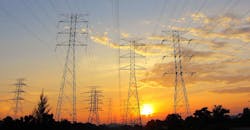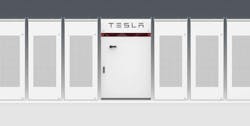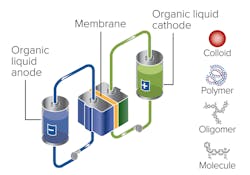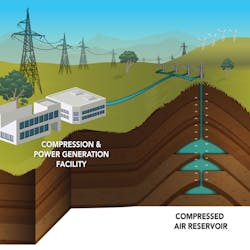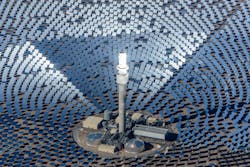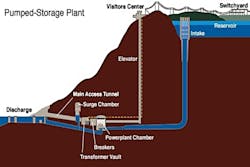6 Promising Energy Storage Options to Tie into the Grid
With renewable energy production on the rise, such as wind and solar, reliable energy storage solutions become a necessity…and especially so when the sun isn’t shining or the wind isn’t blowing. Since the discovery of electricity, scientists have sought methods to store that energy when it’s needed on-demand. Over the last century, the storage industry continued to evolve—and moreso in the 21st Century when new technologies have driven that storage to new levels of efficiency.
The electrical grid is a complex system that requires power supply and demand to be equal at any given moment, which is why viable storage solutions are emerging to help mitigate that power usage. Constant adjustment to the grid is required to maintain stability, and efficient storage will play a significant role in that critical balancing act, providing more flexibility and reliability to the system.
There are some different storage solutions that have been developed over the last few years that can be incorporated into the grid no matter the power or energy requirements—from generation to consumer end use. With that being said, here are six current trending energy storage options that can be implemented into the grid.
1. Tesla Powerwall/Powerpack
(Image credit: Tesla)
Tesla’s Powerwall and Powerpack are highly efficient lithium-ion rechargeable battery platforms, with the Powerpack intended for home use and Powerwall designed for commercial or grid use. The later can be used in multiple applications including peak shaving, demand response, voltage control, and a backup power reserve. A great example of Powerwall integration debuted last year in Australia where a series of battery units provided 129 MW of storage to the Neoen’s Hornsdale Wind Farm, supplying enough power for 30,000 homes.
2. Redox flow battery
(Image credit: JCESR)
Another advanced energy storage solution is redox flow batteries (fuel cell), which replace solid electrodes with energy-dense electrolytic compounds (hydrogen-lithium bromate, bromine-hydrogen, organic, etc.) separated by a membrane that charge and discharge as the liquids circulate in their own respective space. Ion exchange occurs through the membrane separator when the electrolytes undergo reduction and oxidation (redox) and in turn can store large amounts of energy, perfect for tying into the grid.
3. Flywheel energy storage
(Image credit: Steve Wittrig via ABB SlideShare)
Flywheel energy storage functions by accelerating a rotor to high speed and maintaining the power as rotating energy. When that energy is drawn from the system, the flywheel rotational speed is reduced and accelerated when energy is reintroduced.
Most advanced flywheel systems are designed high-strength composite rotors suspended by magnetic bearings, and when power is introduced, the can spin up in a matter minutes to 20,000 to 50,000 RPMs, reaching their energy capacity more quickly than other forms of storage. Swiss automation group ABB recently implemented a flywheel/smart microgrid solution in Kodiak Alaska for renewable energy expansion opportunities and grid stability.
4. Compressed air energy storage
(Image credit: Pacific Northwest National Laboratory)
Compressed air energy storage (CAES) plants are similar to pumped hydro power plants; only instead of pumping water from a lower to an upper pond, ambient air is compressed and stored under pressure in underground caverns to store energy. When that energy is required, the pressurized air is heated and expanded in a turbine, thus driving a generator for power production. The Pacific Northwest National Laboratory is in the process of developing a CAES system for power plants in inland Washington and Oregon areas when additional power is needed for peak demands.
5. Thermal energy storage
(Image credit: SolarReserve)
There are several different types of thermal energy storage, including latent energy storage and thermal-chemical. However, sensible storage is the most used and often paired with solar power plants. A sensible heat system uses a liquid or solid medium: Water, sand, rocks or molten salt are either heated or cooled to store collected energy. SolarReserve’s Nevada Crescent Dunes project is an excellent example of utilizing a TES system, which uses molten salt to store 1,100 MW of power in two massive thermally shielded metal tanks, and can store that energy for 40 years with no degradation.
6. Pumped hydroelectric storage
(Image credit: Wikipedia)
Pumped hydroelectric storage stores energy using water contained in an upper reservoir that is electrically pumped from a lower reservoir. During peak electrical demand, additional power is produced by releasing the stored water through turbines in the same manner as a traditional hydroelectric dam. When the need for energy is reduced, the water is then transferred back up into the higher reservoir usually by the same turbines, which can act as both pump and generator.
According to a 2015 Deloitte report on electrical storage technologies, “The acceleration of new technologies, changing consumer expectations and behaviors, and the structural evolution of the electricity generation and delivery system over the past decade is providing fertile ground for the emergence of maturing electricity storage technologies as key components of the new landscape in electric power.”
With that being said, energy storage is expensive, especially when policies mitigating its use do not place a monetary value on their benefits. This notion is likely to change as more projects and feasibility studies have taken place over the last several years, especially in conjunction with renewable energy sources. With the support of government and industry initiatives, energy storage can continue to be developed, expanded, and aid in the deployment of the continually growing renewable energy sector, as well as traditional fossil fuel-burning power plants.
About the Author
Cabe Atwell
Technology Editor, Electronic Design
Cabe is a Technology Editor for Electronic Design.
Engineer, Machinist, Maker, Writer. A graduate Electrical Engineer actively plying his expertise in the industry and at his company, Gunhead. When not designing/building, he creates a steady torrent of projects and content in the media world. Many of his projects and articles are online at element14 & SolidSmack, industry-focused work at EETimes & EDN, and offbeat articles at Make Magazine. Currently, you can find him hosting webinars and contributing to Electronic Design and Machine Design.
Cabe is an electrical engineer, design consultant and author with 25 years’ experience. His most recent book is “Essential 555 IC: Design, Configure, and Create Clever Circuits”
Cabe writes the Engineering on Friday blog on Electronic Design.
